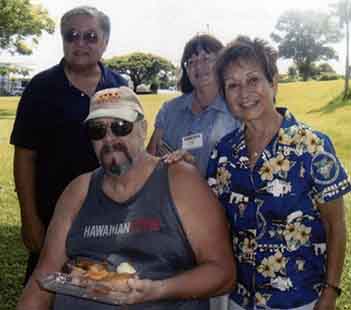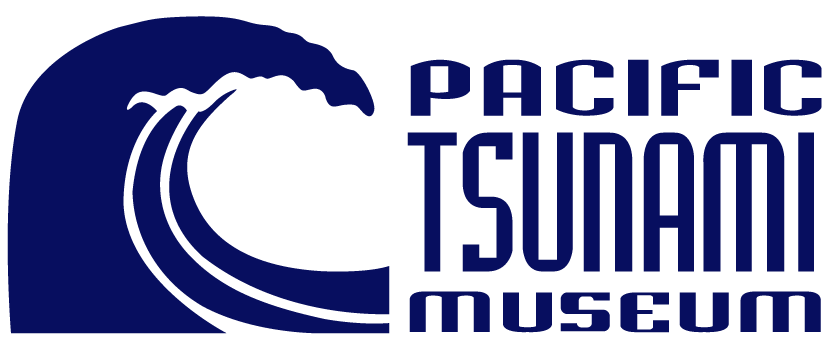Survivor Narratives: 1960
Jim Camp
Heroes Among Us
This story was written and submitted by Wally Camp, an accomplished Hawai’i guidebook writer. He wrote a colorful account about his father, Jim, in the 1960 tsunami.
Jim was a former police officer who was a County Liquor Inspector at the time of the 1960 tsunami. When the warning sounded before the tsunami, Jim and a couple of buddies went to help the owner of the old “Isles Restaurant” evacuate his pinball, shuffleboard, and bowling machines. After they accomplished that task, they helped some of the fishermen secure their boats and proceeded to join a group that had assembled on the Wailoa bridge watching the waves surge in and out. There were policemen, firemen, civil defense workers, and even two tourist couples in a rental car!

With the others on the bridge, Jim looked up and saw the shadow of a huge wave approaching the inlet next to Suisan Fish Market. According to Jim, he broke the existing Olympic and World 100 meter dash records running to his car that was parked in front of the Waiakea Theater. Luckily, the car was a new ’60 Chevy, and it started immediately. He sped off in the direction of the airport on Kamehameha Avenue. Somewhere along the way, he picked up five of the Canario kids and turned right on the old Volcano Hwy. (Kanoelehua Hwy.), stopping near Waldrons. He told the oldest child (Gilbert) to stay with his siblings and if the water got closer, keep driving toward the volcano.
Jim then returned to the area near the Wailoa bridge and started grabbing bodies floating by and pulling people out of the wreckage, some dead, some miraculously still alive! While running so fast, he had lost his slippers, and although Jim had been in Hawai’i for 20 years by this time, he never developed “luau feet” (thick-skinned). Imagine walking and climbing over all of the splintered wood, broken glass and iron roofs, in the dark, and not getting one cut on his feet! Someone was watching over him while he was helping those in need!

Meantime, Jim’s son Wally was home asleep at the family’s Lanihuli St. home. Noise and flickering lights (candles) awakened Wally at approximately 3:45 a.m. Wally had slept through the whole ordeal. The power was out and the noise was coming from the basement, where his Dad was helping four or five now homeless and bewildered men clean up. Most of them were small Japanese men who fit right into Wally’s clothes (his contribution) after they had taken a shower and had something to eat and drink. They all tried to get some sleep before daybreak.
Although all of the men had been told to keep the clothes, over the next few weeks and months, all of Wally’s clothes were returned, washed and pressed! That was Hilo style!
A couple of days after what Wally and his friends called the “tidal wave”, a bunch of Hilo High volunteer boys (including Wally) were assembled, given tetanus shots, shovels, pitchforks, etc. and loaded into sampan buses for “body patrol”. Wally’s group searched part of the Waiakea Peninsula, his old stomping grounds, where he had attended Waiakea Kai School. Thank goodness they didn’t find any bodies!
After the 1960 tsunami, Mr. A.E.P. Wall, then editor of the Tribune-Herald newspaper, wrote that the paper had received the following note from Gilbert and Rita Canario: “We would like to thank Mr. James Camp for his goodness in taking our children to safety. Without his timely presence and calmness, we would have lost them. So to Mr. Camp, “May the Sacred Heart bless and keep you.” Mr. A.E.P. Wall concludes his article saying, “There are many more heroes of the wave whose stories are known only to themselves and those they helped. Heroes don’t often tell about their own work. If someone helped you, write me a note about it. It may be an inspiration to many.”

Interestingly, if Jim had not been a tall man, these events may never have happened. Here is why: Jim was on a ship bound for the Philippines in 1940. Enroute, the ship docked in Honolulu. The local MP Garrison was short on muscle, so every big guy who came down the ship’s gangplank was “Shanghai’d” (recruited). A few months later the Colonel of the 395th heard about Jim’s basketball prowess, and since the Colonel outranked the Provost Marshall, Jim was “cockaroached” (taken) to the outfit at Ft. Ruger on the slopes of Diamond Head with all the local boys. And so Hawai’i became home.
